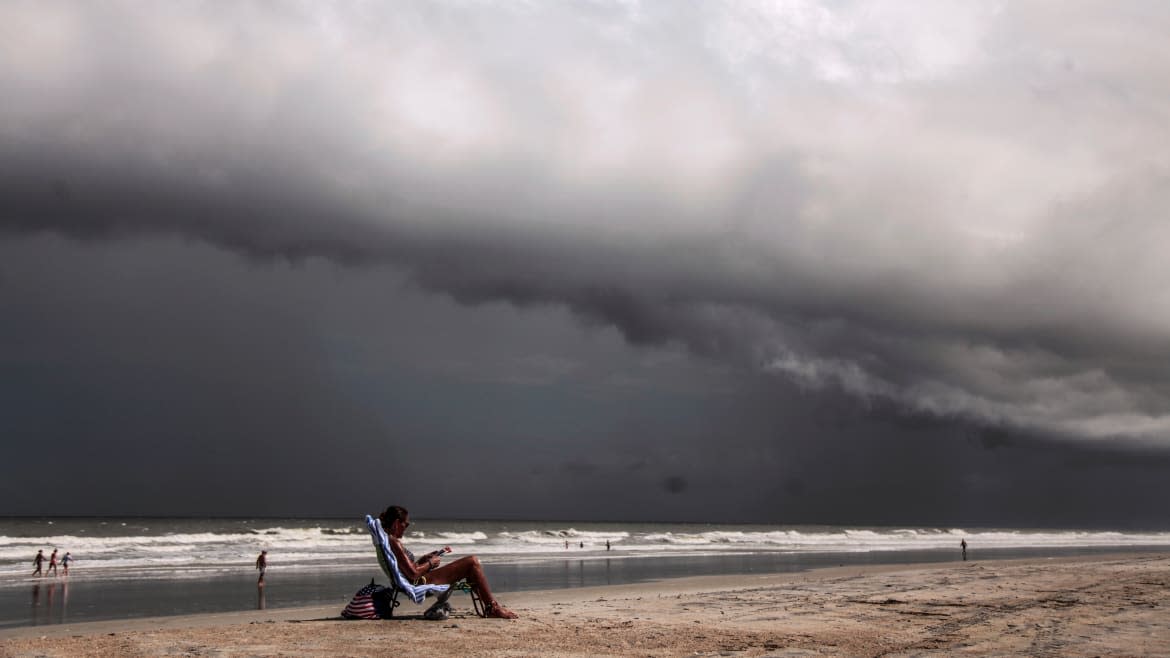Hurricane Dorian: ‘It’s Going to be Extremely Close’ Says Hurricane Specialist

Hurricane Dorian’s winds have howled with gusts of up to 220 mph across the Caribbean, with sustained winds at 185 mph, making it the strongest storm to ever hover east of Florida, or that far north in the Atlantic Ocean, and tying it in second for highest winds ever recorded in the Atlantic.
The merciless storm hit the island of Great Abaco in the Bahamas with that force on Sunday, leaving total devastation. The landfall officially tied Dorian with the decades-old record held by the 1935 Labor Day hurricane for the strongest winds of any storm to hit land. The slowly encroaching Hurricane was moved to Category 5 on Sunday—the highest category on the Saffir–Simpson scale, which classifies hurricanes based off of sustained wind speed.
With just 205 miles between Dorian and the Florida coastline, President Trump made the declaration on Twitter on Sunday that 2019’s Labor Day storm “is looking like one of the largest hurricanes ever.” Later in the day, South Carolina Governor Henry McMaster (R) ordered a mandatory evacuation of the state’s entire coastline in the possibility that Dorian sweeps northward on Wednesday.
Phil Klotzbach, a research scientist at Colorado State University’s Department of Atmospheric Science specializing in Atlantic basin seasonal hurricane forecasts, talked to The Daily Beast about the likelihood that Dorian’s wrath could reach the United States, and the devastation it could cause.
What are the chances that Dorian will hit the United States at the 185 mph speed it is sustaining right now?
As it approaches the United States, it should encounter some stronger vertical wind shear which should begin to weaken the storm somewhat. It’s still forecast to turn north just before it gets to Florida. It’s going to be extremely close, but at this point, an actual landfall seems relatively low.
If it tracks close enough to the coast though, there could still be very substantial impacts including high winds and some storm surge. There could still be a landfall further up the coast in either Georgia or the Carolinas.
What does a Category 5 storm entail?
That generally means pretty much complete destruction for everything in its path.
If Dorian does make landfall on the U.S., what kind of impact could it have on affected states?
It all depends on how close the storm gets. It is going to be tracking perpendicular to the coastline when it approaches, so small angle of approach changes could make huge differences in impacts.
The Slower Hurricane Dorian Moves, the More Dangerous It Is
What makes Dorian different from other recent storms?
Dorian is an extremely powerful hurricane. It has maximum sustained winds of 185 mph. In the Atlantic basin, there’s only been one hurricane with stronger winds: Hurricane Allen in 1980.
How does climate change, the warming ocean, affect hurricanes or specifically this one?
In the area where Dorian underwent its strongest intensification, water temperatures were near average. It’s just that waters near the Bahamas are super hot on average. Currently they’re 85-88°F.
Hurricanes live off of warm ocean hot water, and those kinds of temperatures are like jet fuel for hurricanes. Sea level rise is likely to exacerbate storm surge, since the background sea level will be higher. A warmer atmosphere means more rainfall, since a warmer atmosphere can hold more water vapor. Hurricanes may get a bit stronger (e.g., higher winds) in the future too, although there is a lot of uncertainty there.
Get our top stories in your inbox every day. Sign up now!
Daily Beast Membership: Beast Inside goes deeper on the stories that matter to you. Learn more.

